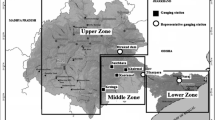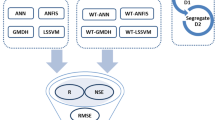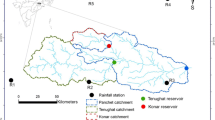Abstract
Because of their sensitive structure, earth dams might face failure due to seepage phenomenon. In order to prevent such failure, some equipment like piezometers are installed in the body or foundation of earth dams. This study investigated the importance of piezometer installation level in dam body or foundation using mutual information–wavelet–Gaussian process regression. 27 Piezometers in three section along with reservoir level were employed to predict one-step-ahead seepage discharge of Zonouz earth dam. The daily data of 1 year of piezometer level and reservoir level were collected for this purpose. In order to find the best possible input combination, three groups of modeling scenarios were defined using piezometers and reservoir level time series. As some input combinations had more than two variables, decomposed time series were imposed into mutual information (MI) tool in order to decrement input variables and find the most correlated input–output features. Afterward, mentioned features were imposed into optimized Gaussian process regression (GPR) to be predicted. Different kernels were selected as core tool of GPR, but results demonstrated the capability of radial basis function (RBF) kernel. GPR–RBF structure were optimized using cross-validation technique. Results indicated that input combination including piezometer level and reservoir level of section II, especially piezometer 203 time series led to the best result among all scenarios.








Similar content being viewed by others
References
Adamowski J, Chan HF (2011) A wavelet neural network conjunction model for groundwater level forecasting. J Hydrol 407:28–40
Aussem A, Campbell J, Murtagh F (1998) Wavelet-based feature extraction and decomposition strategies for financial forecasting. J Comput Intell Finance 6(2):5–12
Candela JQ (2004) Learning with uncertainty-Gaussian processes and relevance vector machines. PhD thesis, Informatics and Mathematical Modelling, Technical University of Denmark, Denmark
Gill MK, Asefa T, Kemblowski MW, Makee M (2006) Soil moisture prediction using Support Vector Machines. J Am Water Resour Assoc 42(4):1033–1046
Goel A, Pa M (2009) Application of support vector machines in scour prediction on grade-control structures. Eng Appl Artif Intell 22(2):216–223
Grossmann A, Morlet J (1984) Decomposition of Hardy function into square integrable wavelets of constant shape. J Math Anal Appl 5:723–736
Ho L, Fatahi B (2015a) Analytical solution for the two-dimensional plane strain consolidation of an unsaturated soil stratum subjected to time-dependent loading. Comput Geotech 67:1–16
Ho L, Fatahi B (2015b) One-dimensional consolidation analysis of unsaturated soils subjected to time-dependent loading. Int J Geomech. doi:10.1061/(ASCE)GM.1943-5622.0000504
Kuss M (2006) Gaussian process models for robust regression, classification, and reinforcement learning. PhD thesis, Technischen Universität, Darmstadt
Legates DR, McCabe GJ Jr (1999) Evaluating the use of goodness-of-fit measures in hydrologic and hydroclimatic model validation. Water Resour Res 35(1):233–241
Mallat SG (1998) A wavelet tour of signal processing, 2nd edn. Academic Press, San Diego
Neal RM (1998) Regression and classification using gaussian process priors. In: Bernardo JM, Berger JO, Dawid AP, Smith AFM (eds) Bayesian statistics. Oxford University Press, Oxford, pp 1–16
Nourani V, Hosseini Baghanam A, Adamowski J, Kisi O (2014) Application of hybrid wavelet-artificial intelligence models in hydrology: a review. J Hydrol 514:358–377
Nourani V, Alizadeh F, Roushangar K (2016) Evaluation of a two-stage SVM and spatial statistics methods for modeling monthly river suspended sediment load. Water Resour Manag 30(1):393–407
Rasmussen CE, Williams CKI (2006) Gaussian processes for machine learning. MIT Press. ISBN:026218253X
Roushangar K, Alizadeh F (2015) Suitability of different modelling strategies in predicting of solid load discharge of an alluvial river. 36th World congress of IAHR, pp 1–10. http://app.iahr2015.info/programma_details/3774
Roushangar K, Koosheh A (2015) Evaluation of GA-SVR method for modeling bed load transport in gravel-bed rivers. J Hydrol 527:1142–1152
Roushangar K, Akhgar S, Salmasi F, Shiri J (2014a) Modeling energy dissipation over stepped spillways using machine learning approaches. J Hydrol 508:254–265
Roushangar K, Mouaze D, Shiri J (2014b) Evaluation of genetic programming-based models for simulating friction factor in alluvial channels. J Hydrol 517:1154–1161
Samui P (2012) Application of relevance vector machine for prediction of ultimate capacity of driven piles in cohesionless soils. Geotech Geol Eng 30(5):1261–1270
Shannon CE (1948) The mathematical theory of communications, I and II. Bell Syst Tech J 27:379–423
Sun AY, Wang D, Xu X (2014) Monthly streamflow forecasting using gaussian process regression. J Hydrol 511:72–81
Terzaghi K (1943) Theoretical Soil Mechanics. John Wiley and Sons, New York
Tiwari MK, Chatterjee Ch (2010) Development of an accurate and reliable hourly flood forecasting model using waveletbootstrap-ANN (WBANN) hybrid approach. J Hydrol 394:458–470
Yang HH, Vuuren SV, Sharma S, Hermansky H (2000) Relevance of time frequency features for phonetic and speaker-channel classification. Speech Commun 31:35–50
Acknowledgments
This work is supported by university of Tabriz. Authors also would like to appreciate East Azerbaijan Regional Water Company for data preparation.
Author information
Authors and Affiliations
Corresponding author
Rights and permissions
About this article
Cite this article
Roushangar, K., Garekhani, S. & Alizadeh, F. Forecasting Daily Seepage Discharge of an Earth Dam Using Wavelet–Mutual Information–Gaussian Process Regression Approaches. Geotech Geol Eng 34, 1313–1326 (2016). https://doi.org/10.1007/s10706-016-0044-4
Received:
Accepted:
Published:
Issue Date:
DOI: https://doi.org/10.1007/s10706-016-0044-4




